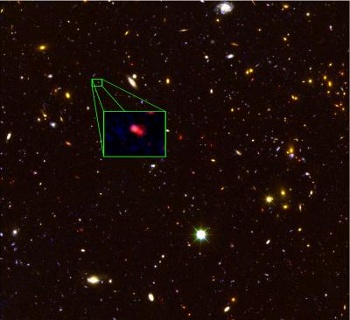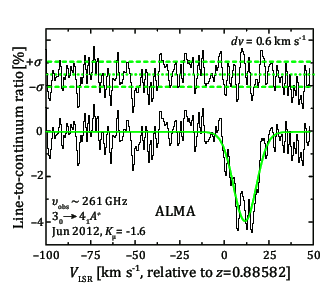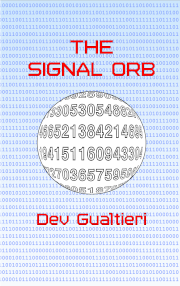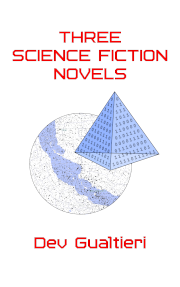Proton to Electron Mass Ratio II
January 6, 2014
I've always found
electric charge to be a mystery.
Protons and
electrons have an identical quantity of electric charge, albeit of opposite
sign (
polarity), although these particles differ in so many ways. First, electrons are
elementary particles, while protons are composite particles composed of
quarks; specifically, two
up quarks and one
down quark.
Secondly, the
masses of the proton and electron differ greatly. The
proton-to-electron mass ratio, commonly symbolized as
μ, is
presently known to be 1836.15267245. I wrote about this mass ratio in a
previous article (Proton to Electron Mass Ratio, January 11, 2013).
In 1951, when this constant was measured to be 1836.12, Friedrich Lenz of Düsseldorf, Germany, published an interesting paper in the Physical Review. This one-sentence paper, conveniently available for purchase at $25.00, states that this ratio was very nearly 6π5 (1836.11810845).[1] The present, more precise, measurement of this number makes this observation less compelling.
Using a computer, it's possible to find other such relationships, but none of these are worthwhile without a backing theory.[2] For example, the Rydberg constant, from which the atomic spectrum of hydrogen is obtained in the Rydberg formula, is within 8 parts per million of (π)2/3 x 1015 when expressed in units of frequency.
The universe has changed considerable from the time of the Big Bang, and it's natural to wonder whether its constituent particles have changed as well. It's conceded that the change could not have been all that large, or the universe could never have evolved into its present state. That's why astronomers, peering back into the early history of the universe by observing objects less than a billion years after the Big Bang, have been refining techniques to discover subtle changes.

In October of this year, astronomers reported on the observation of the most distant galaxy to date, z8-GND-5296.[3]
This galaxy was observed as it appeared 700 million years after the Big Bang, 13.1 billion years ago.
(STScI/NASA image by V. Tilvi, S.L. Finkelstein and C. Papovich, via University of California, Riverside.)
At the end of last year, radio astronomers from the the Max Planck Institute for Radio Astronomy (Bonn, Germany) and the Vrije Universiteit (Amsterdam, The Netherlands) used the 100-meter radio telescope at Effelsberg, Germany to examine the absorption spectrum of methanol in the light of a distant quasar.[4-5] The object of this study was to see whether the proton/electron mass ratio was different at earlier times of the universe.
That quasar, named PKS1830-211, is so distant it could only be imaged because it was lensed by an intervening high redshift (z=0.89) galaxy. Two spectral lines of methanol in the 25 GHz radio band are especially sensitive to the proton-electron mass ratio.[4] The methanol is in intergalactic space in the line of sight of the quasar and Earth, so the quasar acts only as a convenient light source. Within observational limits, the observed mass ratio was the same about 7.5 billion years ago as it is today.[5]
In more recent work, this observation has been refined with the addition of two more radio telescopes to the Effelsberg radio telescope. These other telescopes, observing at additional frequencies, are the IRAM 30-meter telescope on the Spanish Sierra Nevada, and the Atacama Large Millimeter Array (ALMA) in Chile.[6-8] I wrote about ALMA in a previous article (Atacama Large Millimeter Array, March 27, 2013)

The air is rare at the altitude of the Atacama Large Millimeter Array, so this 261 GHz methanol absorption line could be observed.
The upper trace is the residual of the Gaussian fit.
(Fig. 1c of ref. 7, via arXiv.)
The PKS1830-211 signal is the only place where the methanol molecule has been detected in the early Universe. That's the reason for putting so much effort into this study. Other radio telescope studies have looked at intergalactic hydrogen, a molecule not as sensitive to the mass ratio as methanol; or ammonia, which has problems with interpretation.[8]
Seventeen data points for ten different methanol absorption lines were measured, which were sufficient to derive a 1-σ constraint of the variation of the mass ratio, μ of Δμ/μ = (1.5 ± 1.5) x 10−7, and a result that the mass ratio hasn't changed by more than 2 x 10−17 per year.[7]
References:
- Friedrich Lenz, "The Ratio of Proton and Electron Masses," Phys. Rev., vol. 82, no. 4 (May, 1951), pp. 554–554.
- Simon Plouffe , "A search for a mathematical expression for mass ratios using a large database," Plouffe.fr Web Site, April 19, 2004. In this unpublished work, Plouffe ascribes the result of ref. 1 to a later work by Richard Feynman.
- S. L. Finkelstein, C. Papovich, M. Dickinson, M. Song, V. Tilvi, A. M. Koekemoer, K. D. Finkelstein, B. Mobasher, H. C. Ferguson, M. Giavalisco, N. Reddy, M. L. N. Ashby, A. Dekel, G. G. Fazio, A. Fontana, N. A. Grogin, J.-S. Huang, D. Kocevski M. Rafelski, B. J. Weiner and S. P. Willner, "A galaxy rapidly forming stars 700 million years after the Big Bang at redshift 7.51," Nature, vol. 502, no. 7472 (October 24, 2013), pp. 524-527.
- Physical constant passes the alcohol test - Fundamental properties of molecules have not changed during the past seven billion years, Max-Planck-Gesellschaft, München, Press Release, December 13, 2012.
- Julija Bagdonaite, Paul Jansen, Christian Henkel, Hendrick L. Bethlem, Karl M. Menten and Wim Ubachs, "A Stringent Limit on a Drifting Proton-to-electron Mass Ratio from Alcohol in the Early Universe," Science Express, December 13, 2012, DOI: 10.1126/science.1224898.
- J. Bagdonaite, M. Daprà, P. Jansen, H. L. Bethlem, W. Ubachs, S. Muller, C. Henkel and K. M. Menten, "Robust Constraint on a Drifting Proton-to-Electron Mass Ratio at z=0.89 from Methanol Observation at Three Radio Telescopes," Physical Review Letters, vol. 111, no. 23 (December 6, 2013), Document No. 231101 (5 pages).
- J. Bagdonaite, M. Daprà, P. Jansen, H. L. Bethlem, W. Ubachs, S. Muller, C. Henkel and K. M. Menten, "Robust Constraint on a Drifting Proton-to-Electron Mass Ratio at z=0.89 from Methanol Observation at Three Radio Telescopes," arXiv Preprint Server, November 14, 2013.
- Michael Schirber, "Synopsis: Particle Masses Don't Budge," APS Physics Web Site.
Permanent Link to this article
Linked Keywords: Electric charge; proton; electron; sign; polarity; elementary particle; quark; up quark; down quark; mass; proton-to-electron mass ratio; Düsseldorf, Germany; Physical Review; computer; theory; numerical coincidences in numbers from the physical world; Rydberg constant; hydrogen; Rydberg formula; parts per million; hertz; unit of frequency; universe; Big Bang; fine-tuned Universe; astronomer; most distant astronomical objects; galaxy; Space Telescope Science Institute; STScI; NASA; University of California, Riverside; radio astronomy; radio astronomer; Max Planck Institute for Radio Astronomy (Bonn, Germany); Vrije Universiteit (Amsterdam, The Netherlands); 100-meter radio telescope at Effelsberg, Germany; absorption spectroscopy; absorption spectrum; methanol; quasar; gravitational lens; high redshift; spectral line; GHz; radio spectrum; radio band; intergalactic space; Earth; frequency; IRAM 30-meter telescope; Spanish Sierra Nevada; Atacama Large Millimeter Array; Chile; atmosphere of Earth; air; altitude; arXiv; ammonia; standard deviation; 1-σ; Friedrich Lenz, "The Ratio of Proton and Electron Masses," Phys. Rev., vol. 82, no. 4 (May, 1951), pp. 554–554.
 RSS Feed
RSS Feed
Google Search
Latest Books by Dev Gualtieri
Previews Available
at Tikalon Press

STEM-themed novel for middle-school students



Mathematics-themed novel for middle-school students



Complete texts of LGM, Mother Wode, and The Alchemists of Mars

Other Books

Blog Article Directory on a Single Page
Recent Articles
- Eclipse 2024, April 15, 2024
- Reverse Sprinkler, April 8, 2024
- T Coronae Borealis, April 1, 2024
- Coffee and Tea, March 25, 2024
- Arno Penzias (1933-2024), March 18, 2024
- Wave-Particle Duality, March 11, 2024
- Offshore Wind, March 4, 2024
- High Entropy Ceramics, February 26, 2024
- Methane Emissions, February 19, 2024
- Thales, Heron, and Experimental Mathematics, February 12, 2024
- Mica, February 5, 2024
- Disk Packing, January 29, 2024
- Is eπ > πe?, January 22, 2024
- Brownian Motion Energy Harvesting, January 15, 2024
- Coin Flip, January 8, 2024
- Holidays 2023, December 18, 2023
- Fast Radio Bursts, December 11, 2023
- Adhesives, December 4, 2023
- MOND and Planet Nine, November 27, 2023
- Earthquake Light, November 20, 2023
- Antimatter Gravitation, November 13, 2023
- Koch Snowflake, November 6, 2023
- Shared Dessert, October 30, 2023
- Quantum Uncertainty, October 23, 2023
- Sulfur Hexafluoride, October 16, 2023
- Cement Supercapacitors, October 9, 2023
- Fifth Force, October 2, 2023
- The Birthday Problem, September 25, 2023
- Iron as a Fuel, September 18, 2023
- Cosmic Asymmetry, September 11, 2023
- Work, September 4, 2023

Deep Archive
Deep Archive 2006-2008
